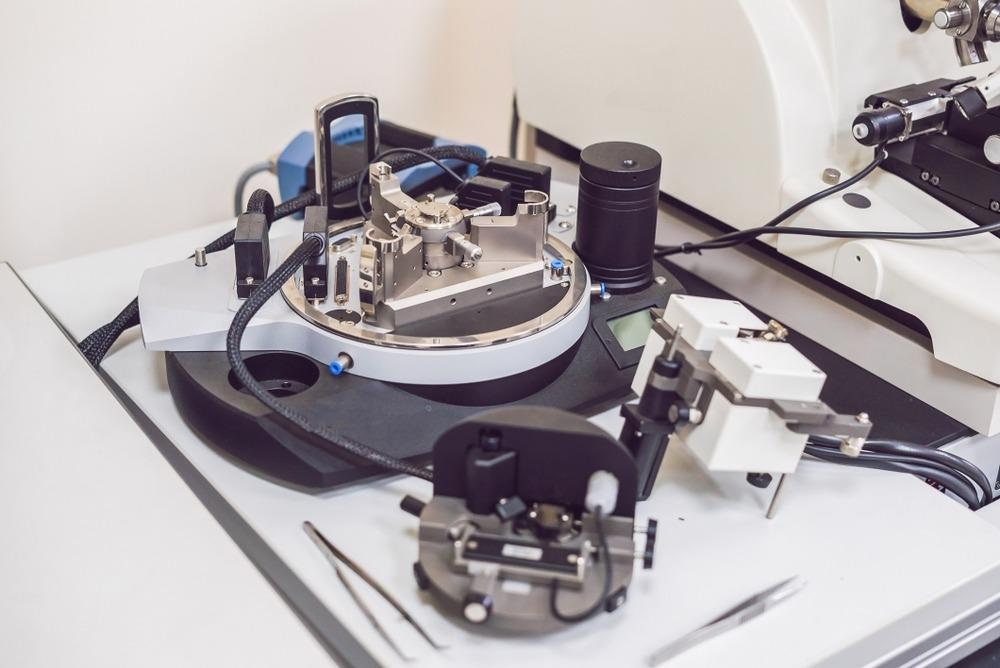AFM is a strong technique for analyzing thin films and coatings, and it may provide useful information that is crucial to the performance of a material or process. AFM assesses nanoscale functionalities, including electrical, magnetic, and mechanical characteristics, by quantifying 3D roughness and texture with unprecedented spatial resolution.

Image Credit: Elizaveta GalitckaiaShutterstock.com
Thin films and coatings are used in everything from food storage to photovoltaics. They are manufactured from a wide range of materials and by a variety of procedures, including deposition, self-assembly, and sol-gel techniques
The technique of generating and linking thin film coatings to a substrate material is known as thin film deposition. Coatings may be constructed from a variety of materials, including metals, oxides, and compounds.
Thin film coatings also have a variety of features that may be used to change or enhance the performance of the substrate. Some are transparent, others are very robust and scratch-resistant, while yet more improve or reduce the conductivity of electrical or signal transmission.
Role of AFM in Characterizing Thin Films
Achieving sub-nanometer to micrometer resolutions in the characterization of these films is critical. Furthermore, the ability to test many functional features at the same time at these scales has emerged as a critical component of thin-film engineering for certain applications.
In the creation, optimization, and monitoring of thin film growth processes, as well as in rationalizing design routes to attain desired functional attributes, atomic force microscopy (AFM) offers crucial information.
Characterization of Ag–In–S films with AFM
In a study in the journal Materials Today: Proccedings, thermal evaporation from a Knudsen cell was used to create ternary Ag–In–S films with a variety of different compositions. It has been discovered by AFM analysis of the produced films that they are smooth and homogenous, with an average surface roughness that ranges from 4 to 5 nanometers for the stoichiometric AgInS2 to around 11 nanometers for the highly Ag-deficient films.
The structure, composition, and characteristics of films are known to be influenced by the production technique, component ratio, and subsequent thermal treatment. The chemical composition of AgInS2 films formed by thermal evaporation is acknowledged to be in good correlation with the loaded component ratio, in contrast to other preparation processes.
XRD measurements reveal that the films are amorphous, containing silver crystallite inclusions visible in the stoichiometric as well as less Ag deficient films, respectively.
The Raman spectra of the amorphous films prepared show a strong correlation with that of AgInS2 polycrystals and Ag–In–S nanocrystals, indicating that silver is built into the amorphous film structure for all of the film compositions and that only a portion of the Ag atoms is contained inside the Ag crystallites revealed by the XRD measurements.
Results of Ag-In-S with AFM Topography
Images of Ag–In–S films with varying component ratios taken with an AFM topography probe reveal that the surfaces of the created films are rather homogenous. The surface roughness of AgInS2 films made by spray pyrolysis, thermal diffusion of silver into In2S3 buffer layers, and electrodeposition were found to be noticeably higher than those of AgInS2 films prepared by other methods.
It was discovered that the occurrence of many crystalline phases may be explained by the presence of smoother surfaces following annealing.
As shown by the Raman spectra of Ag–In–S films with varying component ratios, the main characteristics discovered are relatively similar across all samples. The maxima are substantially larger than those of crystalline AgInS2 or AgIn5S8, which is characteristic of amorphous materials.
Advancements in This Research
Given the existence of a crystalline Ag phase in the films generated by XRD, it was critical to determine if the amorphous phase included a significant quantity of silver or whether all silver precipitates in the nanocrystalline form.
Raman spectroscopy should be used to resolve this problem. At the current count, no Raman investigations of amorphous Ag–In–S materials have been published before. Neither bulk single AgInS2 crystals nor Raman data are present in the literature. As a new advancement in this research, researchers offer an unpolarized spectrum of a polycrystalline AgInS2 sample recorded under identical experimental circumstances for comparison.
The Raman spectra of the amorphous films show a strong correlation with those of AgInS2 polycrystals and Ag–In–S nanocrystals, confirming the presence of all elements in the amorphous films' composition, whereas only a fraction of Ag atoms are contained in Ag crystallites, as indicated by the X-ray data. The amorphous structure of the films generated with silver crystallite inclusions for the stoichiometric and less Ag-deficient films is shown by XRD studies.
References and Further Reading
Azhniuk, Y., et al. (2022). Characterization of Ag–In–S films prepared by thermal evaporation. Materials Today: Proceedings. https://www.sciencedirect.com/science/article/pii/S2214785322009555?via%3Dihub
Asylum Research. (2022). AFM for Thin Films & Coatings. Oxford Instruments Group. https://afm.oxinst.com/application-detail/afm-for-thin-films-and-coatings
Bishop, C. (2015). Process Diagnostics and Coating Characteristics. Vacuum Deposition Onto Webs, Films and Foils (Third Edition). Pages 85-128. https://doi.org/10.1016/B978-0-323-29644-1.00005-0
Disclaimer: The views expressed here are those of the author expressed in their private capacity and do not necessarily represent the views of AZoM.com Limited T/A AZoNetwork the owner and operator of this website. This disclaimer forms part of the Terms and conditions of use of this website.